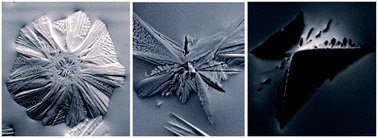当前位置:
X-MOL 学术
›
CrystEngComm
›
论文详情
Our official English website, www.x-mol.net, welcomes your
feedback! (Note: you will need to create a separate account there.)
Oriented surface nucleation and crystal growth in a 18BaO·22CaO·60SiO2 mol% glass used for SOFC seals†
CrystEngComm ( IF 2.6 ) Pub Date : 2018-01-16 00:00:00 , DOI: 10.1039/c7ce02008b Wolfgang Wisniewski 1, 2, 3, 4 , Christian Thieme 1, 2, 3, 4 , Ralf Müller 4, 5, 6 , Stefan Reinsch 4, 5, 6 , Sonja-M. Groß-Barsnick 4, 7, 8, 9 , Christian Rüssel 1, 2, 3, 4
CrystEngComm ( IF 2.6 ) Pub Date : 2018-01-16 00:00:00 , DOI: 10.1039/c7ce02008b Wolfgang Wisniewski 1, 2, 3, 4 , Christian Thieme 1, 2, 3, 4 , Ralf Müller 4, 5, 6 , Stefan Reinsch 4, 5, 6 , Sonja-M. Groß-Barsnick 4, 7, 8, 9 , Christian Rüssel 1, 2, 3, 4
Affiliation

|
A glass of the composition 37BaO·16CaO·47SiO2 wt% produced on an industrial scale is crystallized at 970 °C for times ranging from 15 min to 2 h. The crystallization at the immediate surface as well as the crystal growth into the bulk are analyzed using scanning electron microscopy (SEM) including energy dispersive X-ray spectroscopy (EDXS) and electron backscatter diffraction (EBSD) as well as X-ray diffraction in the Θ–2Θ setup (XRD). The immediate surface shows the oriented nucleation of walstromite as well as the formation of wollastonite and an unknown phase of the composition BaCaSi3O8. All three phases also grow into the bulk where walstromite ultimately dominates the kinetic selection and grows throughout the bulk due to a lack of bulk nucleation. Walstromite shows systematic orientation changes as well as twinning during growth. A critical analysis of the XRD-patterns acquired from various crystallized samples indicates that their evaluation is problematic and that phases detected by XRD in this system should be verified by another method such as EDXS.
中文翻译:

用于SOFC密封 的18BaO·22CaO·60SiO 2 mol%玻璃中定向的表面成核和晶体生长†
以工业规模生产的组成为37BaO·16CaO·47SiO 2 wt%的玻璃在970°C结晶15分钟至2小时。使用包括能量色散X射线光谱法(EDXS)和电子背散射衍射(EBSD)以及扫描仪中的X射线衍射在内的扫描电子显微镜(SEM)分析了表面的结晶以及晶体的生长。Θ – 2Θ设置(XRD)。其直接表面显示出硅镁石的定向成核,硅灰石的形成以及BaCaSi 3 O 8成分的未知相。所有这三个相也都生长成块体,其中辉石最终主导了动力学选择,并且由于缺少块体形核而在整个块体中生长。钨辉石显示出系统的取向变化以及生长过程中的孪生现象。对从各种结晶样品中获得的XRD模式进行的严格分析表明,它们的评估存在问题,并且应通过另一种方法(例如EDXS)验证XRD在该系统中检测到的相。
更新日期:2018-01-16
中文翻译:

用于SOFC密封 的18BaO·22CaO·60SiO 2 mol%玻璃中定向的表面成核和晶体生长†
以工业规模生产的组成为37BaO·16CaO·47SiO 2 wt%的玻璃在970°C结晶15分钟至2小时。使用包括能量色散X射线光谱法(EDXS)和电子背散射衍射(EBSD)以及扫描仪中的X射线衍射在内的扫描电子显微镜(SEM)分析了表面的结晶以及晶体的生长。Θ – 2Θ设置(XRD)。其直接表面显示出硅镁石的定向成核,硅灰石的形成以及BaCaSi 3 O 8成分的未知相。所有这三个相也都生长成块体,其中辉石最终主导了动力学选择,并且由于缺少块体形核而在整个块体中生长。钨辉石显示出系统的取向变化以及生长过程中的孪生现象。对从各种结晶样品中获得的XRD模式进行的严格分析表明,它们的评估存在问题,并且应通过另一种方法(例如EDXS)验证XRD在该系统中检测到的相。











































 京公网安备 11010802027423号
京公网安备 11010802027423号